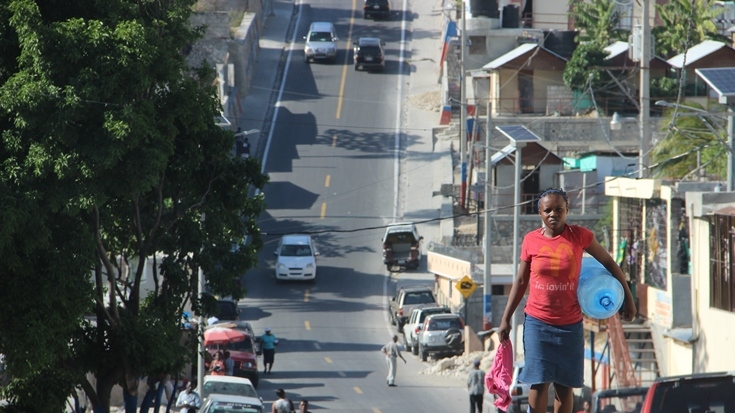It took less than a kilometer of paved road to transform a neighborhood and give it a new momentum: at the southern end of the new Nord-Alexis road (formerly called Ravine Pintade, orguinea fowl in English) new street merchants and motorcycle-taxi drivers are calling out to customers, while young boys play basketball on the flat terrain at the other end of the street. Colored taps-taps, students in uniform walk up and down the slope, residents buy water, and workers continue construction activities on surrounding sites.
A few months ago, cars and even motorcycles could not pass on the dirt road because of a large ditch and large stones blocking the way, remembers Eddy Estimé, an official in the area, whose family has been living in the neighborhood since the days when one could still hunt guinea fowl. Cars could enter the road but had to turn back after a few meters. Like many residents who had been longing for a road, when construction began in 2013, Eddy Estimé doubted it would be completed. "It's a wonderful thing. (..). I sent the photo of the road to my children in the United States. They were amazed; they would have never thought the road would be so wide. "
Twice the minimum daily wage
Aforeman, Wilfried Jean Pierre Louis, who also lives in the area, benefited from the road construction: he was able to practice his skills and saved enough to buy a motorcycle. Resourceful, he became a moto- taxi driver and transports passengers back and forth on the route. "I can earn 500 gourdes daily (equivalent US$ 11 dollars)," he says, twice the average minimum daily wage. The road is useful to the whole community: according to him many cars take this road to avoid traffic jams especially during the peak hours when children go to school.
Access to goods and services has increased, especially providing easier access to water trucks and garbage collection for residents. In addition, the rehabilitation and extension of electrical cable and drinking water networks as well as sanitation, have significantly improved living conditions in the neighborhood.
Sport, light, housing
"After the earthquake, everything here was totally destroyed," says young Pierre Ansy, a ball in hand as he watches his friends play. "We could not play either football or basketball." He is delighted to have this new space at the end of the road where they can play sports. He added: "We have solar street lights so we can play at night." About 30 solar lamps have been installed. According to Pierre, basketball players come from other neighborhoods and they have also received authorities’ permission to close the road and organize a basketball championship.This route is part of the infrastructure rehabilitation and construction component of Port-au-Prince Neighborhood Housing Reconstruction Project (PREKAD) implemented by the Office of Monetization of Development Aid Programs (BMPAD) in several neighborhoods with a US$ 65 million World Bank / Haiti Reconstruction Fund funding . So far, on the North Alexis road alone, 17 houses have been repaired, 20 families have relocated from tents and 14 housing units are under construction.
For Professor Marise D. Geneus, a resident in the community, the road in front of her house is not only an improvement in terms of comfort but also represents a real economic boost "everyone wants to rebuild on their land since there is the road now," she concludes.

